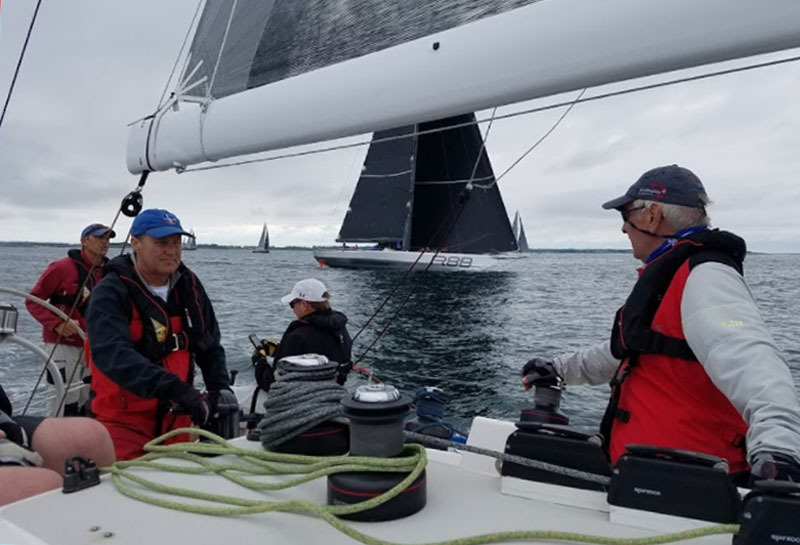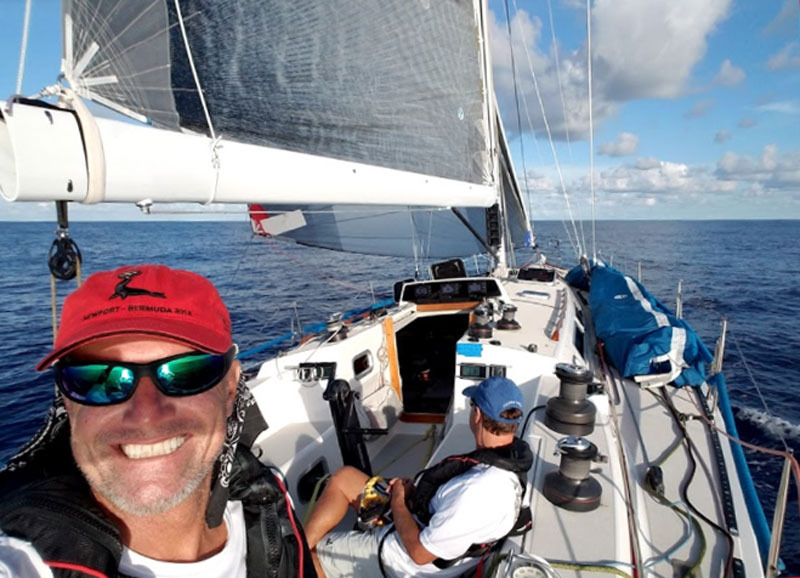
Why We Love the Pacific
The following dispatches come from J/World’s Paul Martson, who was reminded why the Atlantic is not the Pacific, and why the Pacific is so darn appealing. Martson and a few J/World clients sailed in this year’s Newport to Bermuda Race in June aboard Westerly, a Santa Cruz 52. But it was the delivery back to the US that gave them a true taste of what the Atlantic can offer.
Despite the fact that we were the newbies, we won the "Best Performance by a West Coast yacht in the Bermuda Race."

And it was a lovely race to Bermuda in mellow conditions, but afterwards, Mother Nature seemed unhappy about not providing the West Coasters with a proper christening. It blew every day of our time on the island, as if saying, "Come back out, let’s play." It was an invitation gladly accepted, as the direction of the wind allowed for a three-day delivery back to the US, with two days of broad reaching, an abrupt change in wind direction, and a 10- to 15-knot-or-less beat into Newport, Rhode Island. That’s what the NOAA brochure said. And it was true for our departure as well as most of day one.
Day two became unsettled. By evening, we were looking ahead into clouds that we rationalized as just hovering above the Gulf Stream. "Just get through it," we said to ourselves, "and we’ll be in the home stretch." Faint flashes appeared off the bow around dusk as the wind built from 15 to 25. We reached off a bit for comfort and sailed into the darkening sky. Westerly was loving it, almost smiling it seemed, as the surfs became longer and the driving more exciting. Nonetheless, I called for a double reef so we would be prepared for an even wider range of excitement. We talked about the lightning. Where it was once just vaguely ‘out there’, it had become obvious across 180° of the horizon. It would take a major move to avoid, and sailing upwind (or gybing) in 25-plus knots was not appealing (little did we know that 12 hours later we would be doing just that, in even more wind!) The temperature was still warm, with 82-degree water and tropical warmth on deck. The boat surfed, the sun went down, the wind went up, the lightning moved closer. But still no thunder, yet.
Driving went from fun! to concentration mode, with very little conversation outside of need-to-knows. Dinner would not happen this evening. We talked about dropping the jib, but nah, I didn’t want anyone leaving the cockpit. How about the main? Nah, let’s just get this crossing over. Top boat speeds were in the high teens, and were a regular enough occurrence to go unacknowledged. The waxing gibbous moon disappeared, a victim of the clouds that threw electricity with increasing frequency. There were no stars or moon, just 12 instruments scattered around the deck. Around 2 a.m. the wind went cold, peaked at 37.5 knots, and Westerly came down a wave at 20.7 knots. The lightning at this point was straight out of Hollywood, striking the water all around us, destroying our night vision, and etching into our minds what we saw for that split second.

The conditions pulled back a bit from Full On, and the lighter wind went north as we sailed into the header. This is what the forecast called for so we felt pretty good. Now on starboard, we were not terribly low of the layline to Providence. Westerly was close-winded, and even though the heel was significant, we were happy to be on the last segment of the delivery. The forecast called for 15 knots dropping to less in about 100 miles. Instead, it built. And the seas built. And it was cold. The night before it had been warm, but now it was wear-everything-you-brought cold at 3 p.m. Waves started breaking, and Westerly had to be slowed to keep from slamming. Reaching off was not a great option, giving up all those miles made good. So we tried various combos as the wind continued. Mid-20’s again, 60 degrees off the true wind, and it was getting rougher.
The hardest thing about driving was staying on your feet: the heel, the violent and unpredictable motion. The north/northwest wind peaks at 29 knots, but it was the duration of the torment that angered me. We should have been owed a nice approach to New England after last night’s events, right? Instead it was on the nose and nasty.
The feature presentation from that afternoon at the movies (I wish!) was the 8-10′ short and steep waves, with white foam on top. They approached the starboard bow and seemed to make a split-second decision: Slap the hull and shoot straight up into the air, drenching anyone on deck, or sneak under the hull, lift it up, then disappear, leaving the boat to come falling back to the sea with a slam. Both decisions sucked.
It took the entire day and night to finally get Westerly up onto the continental shelf, close enough to the United States to get relief from the seas and wind. By mid-morning we were motoring in calm conditions, enjoying breakfast, hanging everything out to dry, cleaning the boat, and finally, watching Martha’s Vineyard go by. We talked about the past 48 hours, congratulating one another. And about how much we love the Pacific Ocean.
